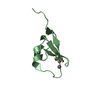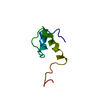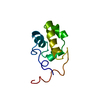+ Open data
Open data
- Basic information
Basic information
| Entry | Database: PDB / ID: 1mg8 | ||||||
|---|---|---|---|---|---|---|---|
| Title | NMR structure of ubiquitin-like domain in murine Parkin | ||||||
 Components Components | Parkin | ||||||
 Keywords Keywords |  APOPTOSIS / APOPTOSIS /  parkinson disease / RIKEN Structural Genomics/Proteomics Initiative / RSGI / parkinson disease / RIKEN Structural Genomics/Proteomics Initiative / RSGI /  Structural Genomics Structural Genomics | ||||||
| Function / homology |  Function and homology information Function and homology informationpositive regulation of neurotransmitter uptake /  regulation protein catabolic process at presynapse / negative regulation of endoplasmic reticulum stress-induced neuron intrinsic apoptotic signaling pathway / mitochondrion-derived vesicle / negative regulation of spontaneous neurotransmitter secretion / negative regulation of intralumenal vesicle formation / PINK1-PRKN Mediated Mitophagy / negative regulation of exosomal secretion / Josephin domain DUBs / mitochondrion to lysosome vesicle-mediated transport ...positive regulation of neurotransmitter uptake / regulation protein catabolic process at presynapse / negative regulation of endoplasmic reticulum stress-induced neuron intrinsic apoptotic signaling pathway / mitochondrion-derived vesicle / negative regulation of spontaneous neurotransmitter secretion / negative regulation of intralumenal vesicle formation / PINK1-PRKN Mediated Mitophagy / negative regulation of exosomal secretion / Josephin domain DUBs / mitochondrion to lysosome vesicle-mediated transport ...positive regulation of neurotransmitter uptake /  regulation protein catabolic process at presynapse / negative regulation of endoplasmic reticulum stress-induced neuron intrinsic apoptotic signaling pathway / mitochondrion-derived vesicle / negative regulation of spontaneous neurotransmitter secretion / negative regulation of intralumenal vesicle formation / PINK1-PRKN Mediated Mitophagy / negative regulation of exosomal secretion / Josephin domain DUBs / mitochondrion to lysosome vesicle-mediated transport / positive regulation of mitochondrial fusion / Regulation of necroptotic cell death / parkin-mediated stimulation of mitophagy in response to mitochondrial depolarization / cellular response to hydrogen sulfide / Aggrephagy / Parkin-FBXW7-Cul1 ubiquitin ligase complex / negative regulation of mitochondrial fusion / free ubiquitin chain polymerization / negative regulation of actin filament bundle assembly / RBR-type E3 ubiquitin transferase / positive regulation of mitophagy in response to mitochondrial depolarization / positive regulation of protein linear polyubiquitination / regulation protein catabolic process at presynapse / negative regulation of endoplasmic reticulum stress-induced neuron intrinsic apoptotic signaling pathway / mitochondrion-derived vesicle / negative regulation of spontaneous neurotransmitter secretion / negative regulation of intralumenal vesicle formation / PINK1-PRKN Mediated Mitophagy / negative regulation of exosomal secretion / Josephin domain DUBs / mitochondrion to lysosome vesicle-mediated transport / positive regulation of mitochondrial fusion / Regulation of necroptotic cell death / parkin-mediated stimulation of mitophagy in response to mitochondrial depolarization / cellular response to hydrogen sulfide / Aggrephagy / Parkin-FBXW7-Cul1 ubiquitin ligase complex / negative regulation of mitochondrial fusion / free ubiquitin chain polymerization / negative regulation of actin filament bundle assembly / RBR-type E3 ubiquitin transferase / positive regulation of mitophagy in response to mitochondrial depolarization / positive regulation of protein linear polyubiquitination /  F-box domain binding / negative regulation by host of viral genome replication / mitochondrion localization / positive regulation of autophagy of mitochondrion / positive regulation of mitophagy / mitochondrial fragmentation involved in apoptotic process / cellular response to toxic substance / dopaminergic synapse / regulation of dopamine metabolic process / regulation of cellular response to oxidative stress / regulation of neurotransmitter secretion / negative regulation of excitatory postsynaptic potential / cellular response to L-glutamate / autophagy of mitochondrion / negative regulation of intrinsic apoptotic signaling pathway by p53 class mediator / protein K6-linked ubiquitination / Antigen processing: Ubiquitination & Proteasome degradation / positive regulation of dendrite extension / norepinephrine metabolic process / positive regulation of proteasomal protein catabolic process / protein localization to mitochondrion / negative regulation of oxidative stress-induced neuron intrinsic apoptotic signaling pathway / positive regulation of protein localization to membrane / negative regulation of JNK cascade / negative regulation of synaptic transmission, glutamatergic / protein K11-linked ubiquitination / protein metabolic process / F-box domain binding / negative regulation by host of viral genome replication / mitochondrion localization / positive regulation of autophagy of mitochondrion / positive regulation of mitophagy / mitochondrial fragmentation involved in apoptotic process / cellular response to toxic substance / dopaminergic synapse / regulation of dopamine metabolic process / regulation of cellular response to oxidative stress / regulation of neurotransmitter secretion / negative regulation of excitatory postsynaptic potential / cellular response to L-glutamate / autophagy of mitochondrion / negative regulation of intrinsic apoptotic signaling pathway by p53 class mediator / protein K6-linked ubiquitination / Antigen processing: Ubiquitination & Proteasome degradation / positive regulation of dendrite extension / norepinephrine metabolic process / positive regulation of proteasomal protein catabolic process / protein localization to mitochondrion / negative regulation of oxidative stress-induced neuron intrinsic apoptotic signaling pathway / positive regulation of protein localization to membrane / negative regulation of JNK cascade / negative regulation of synaptic transmission, glutamatergic / protein K11-linked ubiquitination / protein metabolic process /  synaptic transmission, dopaminergic / positive regulation of tumor necrosis factor-mediated signaling pathway / synaptic transmission, dopaminergic / positive regulation of tumor necrosis factor-mediated signaling pathway /  mitochondrial fission / mitochondrial fission /  aggresome assembly / ubiquitin conjugating enzyme binding / regulation of mitochondrion organization / aggresome assembly / ubiquitin conjugating enzyme binding / regulation of mitochondrion organization /  aggresome / positive regulation of mitochondrial membrane potential / regulation of reactive oxygen species metabolic process / regulation of synaptic vesicle endocytosis / dopamine uptake involved in synaptic transmission / positive regulation of mitochondrial fission / dopamine metabolic process / intracellular vesicle / ubiquitin-specific protease binding / positive regulation of ATP biosynthetic process / aggresome / positive regulation of mitochondrial membrane potential / regulation of reactive oxygen species metabolic process / regulation of synaptic vesicle endocytosis / dopamine uptake involved in synaptic transmission / positive regulation of mitochondrial fission / dopamine metabolic process / intracellular vesicle / ubiquitin-specific protease binding / positive regulation of ATP biosynthetic process /  startle response / negative regulation of release of cytochrome c from mitochondria / protein monoubiquitination / regulation of postsynaptic membrane neurotransmitter receptor levels / protein K63-linked ubiquitination / cullin family protein binding / positive regulation of insulin secretion involved in cellular response to glucose stimulus / startle response / negative regulation of release of cytochrome c from mitochondria / protein monoubiquitination / regulation of postsynaptic membrane neurotransmitter receptor levels / protein K63-linked ubiquitination / cullin family protein binding / positive regulation of insulin secretion involved in cellular response to glucose stimulus /  phospholipase binding / phospholipase binding /  mitophagy / regulation of protein ubiquitination / negative regulation of mitochondrial fission / negative regulation of insulin secretion / negative regulation of reactive oxygen species metabolic process / protein K48-linked ubiquitination / protein autoubiquitination / negative regulation of endoplasmic reticulum stress-induced intrinsic apoptotic signaling pathway / mitophagy / regulation of protein ubiquitination / negative regulation of mitochondrial fission / negative regulation of insulin secretion / negative regulation of reactive oxygen species metabolic process / protein K48-linked ubiquitination / protein autoubiquitination / negative regulation of endoplasmic reticulum stress-induced intrinsic apoptotic signaling pathway /  ubiquitin ligase complex / negative regulation of reactive oxygen species biosynthetic process / ubiquitin ligase complex / negative regulation of reactive oxygen species biosynthetic process /  Hsp70 protein binding / Hsp70 protein binding /  heat shock protein binding / response to endoplasmic reticulum stress / mitochondrion organization / heat shock protein binding / response to endoplasmic reticulum stress / mitochondrion organization /  tubulin binding / adult locomotory behavior / regulation of mitochondrial membrane potential / negative regulation of protein phosphorylation / locomotory behavior / tubulin binding / adult locomotory behavior / regulation of mitochondrial membrane potential / negative regulation of protein phosphorylation / locomotory behavior /  ubiquitin binding / ubiquitin binding /  synaptic transmission, glutamatergic / synaptic transmission, glutamatergic /  learning / learning /  regulation of autophagy / G protein-coupled receptor binding / regulation of autophagy / G protein-coupled receptor binding /  PDZ domain binding / proteasomal protein catabolic process / protein catabolic process PDZ domain binding / proteasomal protein catabolic process / protein catabolic processSimilarity search - Function | ||||||
| Biological species |   Mus musculus (house mouse) Mus musculus (house mouse) | ||||||
| Method |  SOLUTION NMR / SOLUTION NMR /  simulated annealing simulated annealing | ||||||
 Authors Authors | Tashiro, M. / Okubo, S. / Shimotakahara, S. / Hatanaka, H. / Yasuda, H. / Kainosho, M. / Yokoyama, S. / Shindo, H. / RIKEN Structural Genomics/Proteomics Initiative (RSGI) | ||||||
 Citation Citation |  Journal: J.Biomol.NMR / Year: 2003 Journal: J.Biomol.NMR / Year: 2003Title: NMR structure of ubiquitin-like domain in PARKIN: Gene product of familial Parkinson's disease. Authors: Tashiro, M. / Okubo, S. / Shimotakahara, S. / Hatanaka, H. / Yasuda, H. / Kainosho, M. / Yokoyama, S. / Shindo, H. #1:  Journal: Nature / Year: 1998 Journal: Nature / Year: 1998Title: Mutations in the parkin gene causes autosomal recessive juvenile parkinsonism Authors: Kitada, T. / Asakawa, S. / Hattori, N. / Matsumine, H. / Yamamura, Y. / Minosima, S. / Yokochi, M. / Mizuno, Y. / Shimizu, N. | ||||||
| History |
|
- Structure visualization
Structure visualization
| Structure viewer | Molecule:  Molmil Molmil Jmol/JSmol Jmol/JSmol |
|---|
- Downloads & links
Downloads & links
- Download
Download
| PDBx/mmCIF format |  1mg8.cif.gz 1mg8.cif.gz | 255.8 KB | Display |  PDBx/mmCIF format PDBx/mmCIF format |
|---|---|---|---|---|
| PDB format |  pdb1mg8.ent.gz pdb1mg8.ent.gz | 210.9 KB | Display |  PDB format PDB format |
| PDBx/mmJSON format |  1mg8.json.gz 1mg8.json.gz | Tree view |  PDBx/mmJSON format PDBx/mmJSON format | |
| Others |  Other downloads Other downloads |
-Validation report
| Arichive directory |  https://data.pdbj.org/pub/pdb/validation_reports/mg/1mg8 https://data.pdbj.org/pub/pdb/validation_reports/mg/1mg8 ftp://data.pdbj.org/pub/pdb/validation_reports/mg/1mg8 ftp://data.pdbj.org/pub/pdb/validation_reports/mg/1mg8 | HTTPS FTP |
|---|
-Related structure data
| Similar structure data | |
|---|---|
| Other databases |
- Links
Links
- Assembly
Assembly
| Deposited unit | 
| |||||||||
|---|---|---|---|---|---|---|---|---|---|---|
| 1 |
| |||||||||
| NMR ensembles |
|
- Components
Components
| #1: Protein | Mass: 8918.294 Da / Num. of mol.: 1 / Fragment: ubiquitin-like domain / Source method: isolated from a natural source / Source: (natural)   Mus musculus (house mouse) / Plasmid: pET28b / Strain: BL21 (DE3) / References: UniProt: Q9WVS6 Mus musculus (house mouse) / Plasmid: pET28b / Strain: BL21 (DE3) / References: UniProt: Q9WVS6 |
|---|
-Experimental details
-Experiment
| Experiment | Method:  SOLUTION NMR SOLUTION NMR | ||||||||||||
|---|---|---|---|---|---|---|---|---|---|---|---|---|---|
| NMR experiment |
| ||||||||||||
| NMR details | Text: The structure was determined using triple-resonance NMR spectroscopy. |
- Sample preparation
Sample preparation
| Details | Contents: 1mM ubiquitin-like domain U-15N,13C; 25mM acetate buffer NA, 2mM dithiothreitol-d10 Solvent system: 90% H2O/10% D2O |
|---|---|
| Sample conditions | pH: 5.0 / Pressure: ambient / Temperature: 298 K |
Crystal grow | *PLUS Method: other / Details: NMR |
-NMR measurement
| Radiation | Protocol: SINGLE WAVELENGTH / Monochromatic (M) / Laue (L): M | ||||||||||||||||||||
|---|---|---|---|---|---|---|---|---|---|---|---|---|---|---|---|---|---|---|---|---|---|
| Radiation wavelength | Relative weight: 1 | ||||||||||||||||||||
| NMR spectrometer |
|
- Processing
Processing
| NMR software |
| ||||||
|---|---|---|---|---|---|---|---|
| Refinement | Method:  simulated annealing / Software ordinal: 1 simulated annealing / Software ordinal: 1 | ||||||
| NMR ensemble | Conformer selection criteria: structures with the lowest energy Conformers calculated total number: 50 / Conformers submitted total number: 10 |
 Movie
Movie Controller
Controller











 PDBj
PDBj


